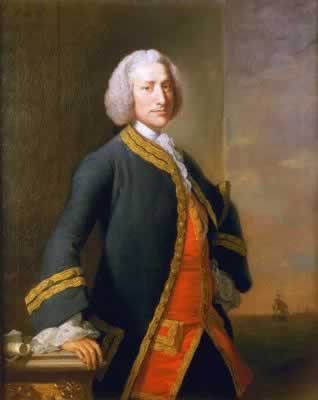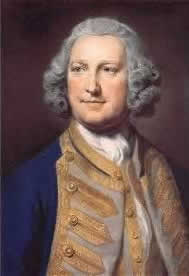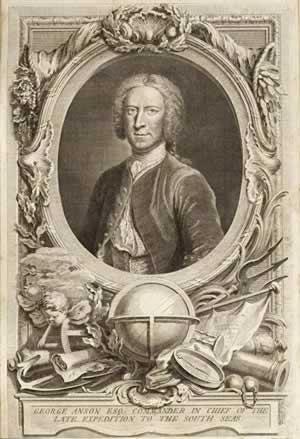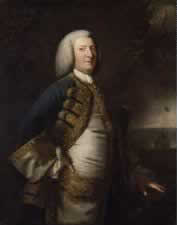Think that you may own a portrait of Admiral George Anson? We identify, appraise and issue Certificates of Authenticity (COA) for all portraits of George Anson.

George Anson, National Maritime Museum
Admiral George Anson was a British admiral and a wealthy aristocrat, noted for his circumnavigation of the globe. George's father was William Anson of Shugborough in Staffordshire and his mother was Isabella Carrier, who was the sister-in-law of Thomas Parker, 1st Earl of Macclesfield, the Lord Chancellor, a relationship that proved very useful to the future admiral.

George Anson, Artist Unknown
George Anson entered the navy in February 1712, and by rapid steps became lieutenant in 1716, commander in 1722, and post-captain in 1724. In this rank, he served twice on the North American station as captain of HMS Scarborough and of Squirrel from 1724 to 1730 and from 1733 to 1735. In 1737 he gained the command of the ship of the line, Centurion 60. In 1740, on the eve of the War of the Austrian Succession (1740–1748), he became commander (with the rank of commodore) of the squadron sent to attack Spanish possessions in South America.

Portrait of George Anson, painted by Ar. Pond, engraved by C. Grignion
The expedition failed to carry out its original ambitious scheme. Anson's ill-equipped squadron that sailed later than intended, consisted of six warships: Centurion 60 (his flagship), Gloucester 50, Severn 50, Pearl 40, Wager 28, and the sloop Tryal, plus the two store ships Anna and Industry. Successive disasters eventually reduced his force to just Centurion. Two of his vessels, Pearl and Severn, failed to round the Horn and returned home. Wager was wrecked off the coast of Chile. The lateness of the season forced him to round Cape Horn in very stormy weather, and the navigating instruments of the time did not allow for exact observations. By the time Anson reached the island of Juan Fernández in June 1741, only three of his six ships remained, while the strength of his crews had fallen from 961 to 335. In the absence of any effective Spanish force on the coast, he was able to harass the enemy and to sack the small port city of Paita in Peru (13 – 15 November 1741). The steady decrease of his crew by sickness, and the worn-out state of his remaining consorts, compelled him to collect all the remaining survivors in Centurion. He rested at the island of Tinian, and then made his way to Macao in November 1742.
After considerable difficulties with the Chinese, he sailed again with his one remaining vessel to cruise in search of one of the richly laden galleons that conducted the trade between Mexico and the Philippines. The indomitable perseverance he had shown during one of the most arduous voyages in the history of sea adventure gained the reward of the capture of an immensely rich prize, Nuestra Señora de Covadonga, possessing 1,313,843 pieces of eight, which he encountered off Cape Espiritu Santo on 20 June 1743. Anson took his prize back to Macao, sold her cargo to the Chinese, and sailed for England, which he reached via the Cape of Good Hope on 15 June 1744. The prize money earned by the capture of the galleon had made him a rich man for life.
Anson's chaplain, Richard Walter, recorded the circumnavigation, which he included in A Voyage Round the World published in 1748. It is, "written in brief, perspicuous terms", wrote Thomas Carlyle in his History of Friedrich II, "a real poem in its kind, or romance all fact; one of the pleasantest little books in the world's library at this time".
Anson was Member of Parliament (MP) for Hedon for 1744 to 1747. In 1747, Anson commanded the fleet that defeated the French Admiral de la Jonquiére at the First Battle of Cape Finisterre, capturing four ships of the line, two frigates and seven merchantmen. In consequence, Anson became very popular, and was promoted to Vice Admiral and elevated to the peerage as Baron Anson of Soberton.
Anson subsequently continued his naval career with distinction as an administrator, becoming First Lord of the Admiralty (1757–1762). Seven British warships have borne the name HMS Anson in his honor.
Despite the fact that today George Anson is a relatively forgotten explorer, there are a handful of portraits of this admiral in existence. Many of them are copies from an original by Joshua Reynolds, housed at the National Portrait Gallery, and were likely painted post mortem. Because he was an explorer, it is possible that one may find his likeness in a seafaring artists sketchbook or on some remote island somewhere.

Portrait of George Anson, after Sir Joshua Reynolds at The National Portrait Gallery
